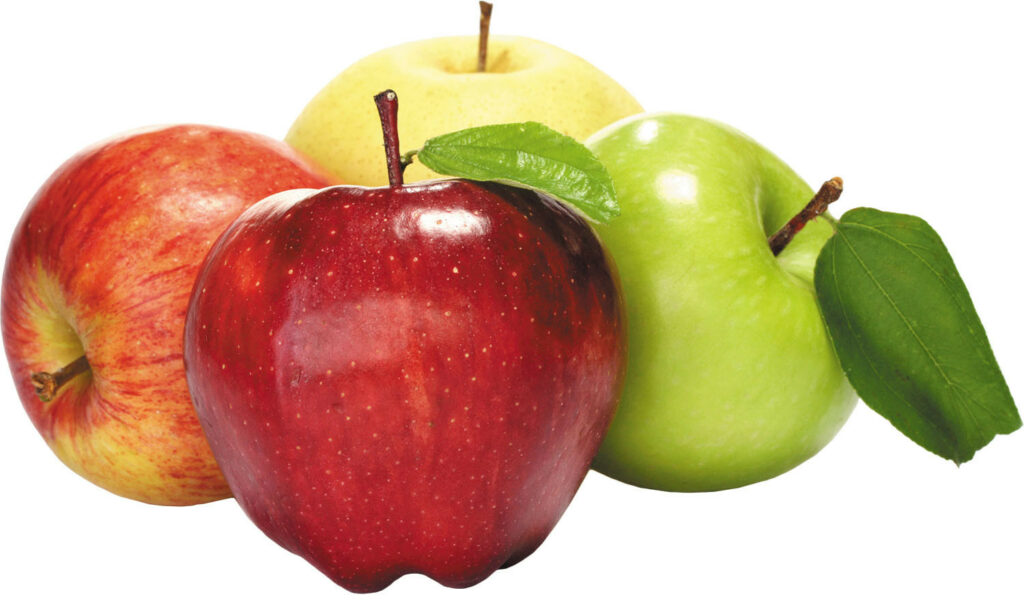The origin and Health Benefits of Apples: Autumn’s wonderful treat!
Category: Healthy Nutrition

Apples, apples what a treat
Sweet and tart and good to eat
Apples grown and apples red
Hang from branches overhead
And when they ripen, down they drop
So we can taste our apple crop.
International Apple Day falls in September, on the 21st this year. There is an apple today for every taste. Options range from the very bitter Granny Smith to the sweet crunch of Honey Crisp. There are many more different choices in between. It seems every year there is a different apple introduced.
Apples are not just tasty to crunch, or bake. They are rich in nutrients: fibers, vitamins, and antioxidants. A great snack choice. Apples help protect us against diseases, support immune health, and even help to manage our weight.
Besides crunching, you can bake then, roast them, caramelize them, pie them, and even dunk for them!
Origin of the Apple:

Apples are not native to the US. There originated in Central Asia, in the Tien Shan mountains of mainly Kyrgyzstan and and parts of northwestern China. Traders along the Silk Road brought them to Europe. And the European colonists brought them to the United States.
Unfortunately you cannot grow an Apple tree from a seed of today’s apples. The tree you would grow would not resemble the apple you just ate. Apples must be propagated to attain the characteristics of the original apple. You have to plant more than one apple tree for it to pollinate. Our precious honey bee is responsible for most of the fertilization.
Johnny Appleseed/ John Chapman

Johnny Appleseed, his name was actually John Chapman (born September 26, 1774, Leominster, Massachusetts—died March 18?, 1845, near Fort Wayne, Indiana, U.S.) was an American missionary nurseryman of the North American frontier. He did not wear a pail on his head, nor did he walk barefoot as legend has it. But he did help to create apple-tree nursery stock throughout the Midwest.
Johnny Appleseed was a conservationist, frontiersman, and early horticulturist. He owned more than 1,200 acres of land across PA, Ohio, IN, and IL. He passed away near Fort Wayne, IN.
Chapman was quite eccentric, loved to develop nurseries. He did not believe in grafting a tree. Thus, his apples were small and tart. They were better suited to hard cider!
John Chapman will always be known as Johnny Appleseed for his dedication on bringing apple trees to the Midwest.
“An apple a day keeps the doctor away!”

Apples are quite popular and are ranked among the top three fruits of the world! They are easy to store and transport.
One serving of an apple provides 95 calories, 0 grams fat, 1 gram of protein, 25 grams of carbohydrates, 19 natural grams of sugar, and 3 grams of soluble and insoluble fiber.
An apple contains Vitamin C. It also gives us phytochemicals: quercetin, catechin, chlorogenic acid, and anthocyanin.
What do phytochemicals do for us? They protect your cells from damage caused by environmental toxins and the body’s natural chemical (metabolic) processes. “Phytochemicals have antioxidant properties and offer protection that decreases the risk of many diseases.”
UCLAhealth.org: “Phytochemicals also work as antimicrobial agents. They reduce the chance that viruses and bacteria (that) can grow in the body. Early research suggests that when an infection does occur, phytochemicals help ensure your immune system has an appropriate response. They can also reduce ongoing inflammation associated with inflammatory diseases.
Phytochemicals act as chemoprevention — they hinder cancer development — by preventing DNA damage. They can also repair mutated genes, slow cancer growth and help abnormal cells die more quickly. Making simple dietary changes to include more phytochemicals provides a safe, cost-effective way to prevent cancer.” (1)
When you peel an apple, you lose much of the fiber and the majority of flavonoids. (Quercetin: a flavonoid that has anti-inflammatory properties.)
We have heard that apples are good sources of Pectin. Pectin is a soluble fiber that may help prevent constipation, a modest effect on lowering LDL (the bad cholesterol). It can also help prevent some chronic diseases, including some cancers, and bowel disorders.
Sounds like a good idea to add that Apple a Day!
What about the pesticides?

We know that our fruit is heavily sprayed to prevent bugs and diseases. Who wants to eat a wormy apple? Most apples are washed before being sold. However, the remaining amount of pesticide is unknown. The type of pesticide is also unknown. Additionally, the residue left is unknown.
Although some pesticide residue can permeate the flesh, washing and peeling removes much of it. However, you are removing a lot of the nutrition. FDA suggests just a good scrubbing with water will work. No soap.
If you are concerned about pesticides, it is recommended to soak the apples in a baking soda solution. Use 1 teaspoon of baking soda and 2 cups of water. Soak for 10-15 minutes. Then rinse well. Dry thoroughly before storing.
Right now it is said that the benefits of eating an apple outweigh the potential pesticide risk.

To store apples:
Usually apples will stay fresh in your crisper drawer of your refrigerator for 1-2 months. Apples do continue to ripen after being picked. Store apples in their own drawer as they emit a gas that will speed the ripening of other fruits.
Apples will last on your counter for about 1-2 weeks, but the texture will change.
Which one: Apple juice or Apple Cider?

Apple juice has been filtered to remove solids. It is pasteurized so it remains fresher longer. Sugar is sometimes added. During filtration, the flavors of tart and bitterness from the natural apple flavonoids are removed. Apple juice is usually has a uniform sweet flavor.
Apple cider is produced from mashed raw apples that are pressed to extract the liquid. It is not filtered. It is sold pasteurized and unpasteurized. It can appear cloudy as it contains pulp and sediment. It is more acidic and contains more flavonoids than apple juice.
Now for the tasty part: a suggested easy recipe!
- Number one favorite can be to slice the apple, and spread peanut butter on the slices!
2. Enjoy crisp apples with cheese. My kiddos loved this for an after school snack. I added whole wheat crackers.
Microwave “Baked” Apple for One.

Microwave “Baked” Apple for One
1 cored apple. Place in bowl with largest part of hole up.
Fill the hole with 1.1/2 tsp sugar, cinnamon, or even pumpkin spice. Add raisins or nuts as desired. You can even drizzle with maple syrup.
Wrap tightly your bowl in plastic wrap. Try to make air tight. The plastic wrap will bubble as apple cooks. It works like a steamer. Microwave on High for 5 minutes.
Remove from microwave oven, WITH GLOVES. The bowl will be quite HOT. Let Cool 5 minutes.
Serve alone or with ice cream, crumble cookies, crumbled graham crackers, or evaporated milk or 1/2 and 1/2. ENJOY!!
HUGS!
References:
https://www.wellnessmaryjessen.com
https://www.schoolhousebythesea.com/students/poems-and-verses/apples/
https://en.wikipedia.org/wiki/Apple
https://www.google.com/search?q=johnny+appleseed
(1) https://www.uclahealth.org/news/article/what-are-phytochemicals-and-why-should-you-eat-more-them
https://www.allrecipes.com/recipe/18389/microwave-baked-apples/


Facebook Comments